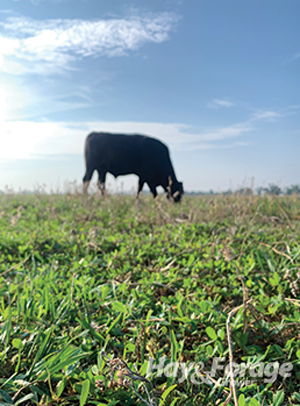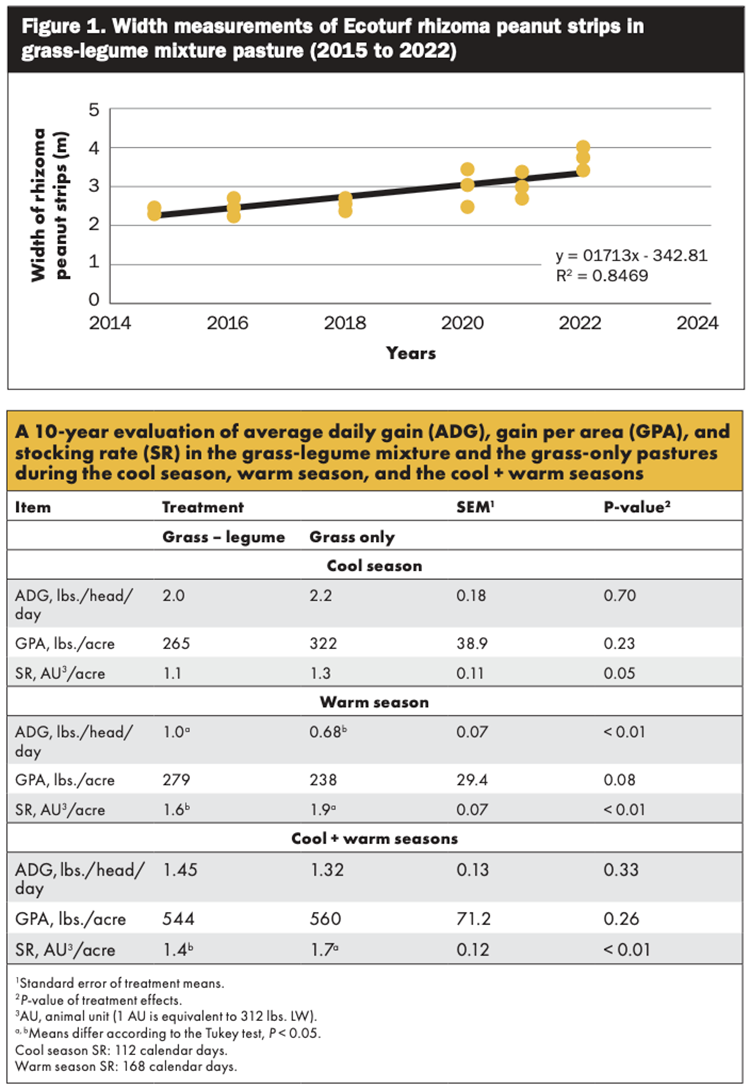
Rhizoma peanut is usually planted as a hay crop, but it grows well in mixtures with warm-season perennial grasses, including bahiagrass. A 10-year study was conducted at the University of Florida’s North Florida Research and Education Center (NFREC) in Marianna, Fla., assessing the inclusion of legume species in both cool and warm seasons and comparing it to a grass-only system with a high N fertilization rate of 200 pounds of N per acre per year.
In the cool season, the grass-legume system has a mix of ryegrass, oats, and a blend of clovers, including crimson, red, and ball clovers, with 30 pounds of N per acre to help establish these cool-season species. During the warm season, the system is composed of a bahiagrass-rhizoma peanut mixture with no additional N application. The bahiagrass-rhizoma peanut mixture was established in 2014 using strip-planting methodology, and it has never been replanted (see graph).
Changes over time
At the beginning of the experiment, the rhizoma peanut and bahiagrass strips were well defined; however, after 10 years of grazing management, the species have spread laterally, transforming the system into a uniform grass-legume mixture. The grass-only system in the cool season is overseeded with oats and ryegrass (or rye), and it remained a bahiagrass monoculture in the warm season. The annual 200 pounds of N per acre was split equally in both seasons.
Integrating legumes enhanced herbage responses since the system benefits from the complementary growth distribution of each species, extending the length of the grazing season throughout the year. Greater biodiversity improved resilience to weather conditions, and this was observed in the long-term evaluation, which resulted in a more stable grazing system demonstrated by animal performance. Furthermore, the inclusion of forage legumes improved the overall nutritive value in the animals’ diet, potentially boosting cattle gains.
Animals fed with grass-legume mixtures usually had greater performance compared to grass monocultures. Adding legume species resulted in similar animal performance while reducing external N fertilizer use by 85%. The total animal liveweight gain (cool plus warm season) did not differ among treatments, averaging 560 pounds per acre for the grass-legume mixture and 544 pounds per acre for the grass-only stand (see table). Fecal analysis from animals fed grass-legume mixtures in grazing conditions indicated a preference by animals toward the rhizoma peanut, and the averaged selection index for the warm season was 1.5.

An efficient utilization
Biological N fixation is considered one of the most important ecosystem services provided by a leguminous species. It is a symbiosis between plant roots and soil microorganisms that results in the fixation of atmospheric N2 into the plant-soil-animal interface. Nitrogen is a key element to help build proteins for plant and animal growth, and this process not only helps introduce it to the system but also reduces the need for N fertilizers and lowers system losses.
Our results showed that using a variety of forage legumes throughout the year contributed a total biological N fixation of 124 pounds per acre per year, with approximately 50% of this total being fixed in each season. The cool-season biological N fixation contributed 59 pounds of N per acre, while warm-season fixation contributed 65 pounds of N per acre. The N utilized by plants provided by biological N fixation is a more efficient nutrient utilization because the N is already in the plant, and it is not free to be lost, unlike external N fertilizers.
N2-fixing legumes help regulate N losses through gases and leaching compared to the use of off-farm inputs. After the N fertilizer application, gaseous losses, via ammonia volatilization and nitrous oxide, represent about 50% to 60% of the total N applied. Moreover, the indiscriminate use of N fertilizers combined with the natural characteristics of sandy soils raises the odds of leaching losses. All these losses have a great impact on farmers’ income and the environment.
Other ecosystem services provided by this system include more complex nutrient cycling within the soil-plant-animal-atmosphere nexus, which continuously releases nutrients back into the system. As a result, the grass-legume mixture can remain productive if external N fertilizers are removed because N fixation continues. On the other hand, if external N fertilizers are cut from the grass-only system, this system will eventually collapse due to a lack of an additional N source.

Fewer inputs needed
The grass-legume mixture is more stable, as demonstrated by the previously presented results. Furthermore, greater system flexibility and reduced dependence on external off-farm inputs enhance and highlight the system’s sustainability. Other ecosystem services include habitats for pollinators and wildlife, help in soil carbon storage, and the regulation of greenhouse gases, either through enteric methane emissions or emissions from excreta and the soil.
Despite the numerous benefits of incorporating legumes, this practice still faces some obstacles in widespread agricultural use. Scaling up the use of these species requires overcoming the costs of initial propagation material and other management challenges. Some of the challenges include the need for a specific herbicide to keep grass-legume mixtures free of weeds, the need for careful grazing management to prevent overgrazing the legume component, and the need to find new legume species and varieties for different soil and climate conditions. Further research is necessary to explore different options for addressing these issues and promoting greater adoption.
The multifunctionality of N2-fixing legumes enhances farm profitability. Adding legumes into grass pastures reduces dependence on N fertilizers without compromising cattle performance, thereby potentially improving economic returns. Grass-legume mixtures resulted in similar animal performance to a grass-only system with a high N fertilization rate, yet the grass-legume mixture achieved this with fewer animals and an 85% reduction in fertilizer inputs. Finally, enhancing the system’s biodiversity, especially by adding legumes, produces a more efficient utilization of N, improving the system’s stability.
This article appeared in the November 2025 issue of Hay & Forage Grower on page 22.
Not a subscriber? Click to get the print magazine.

